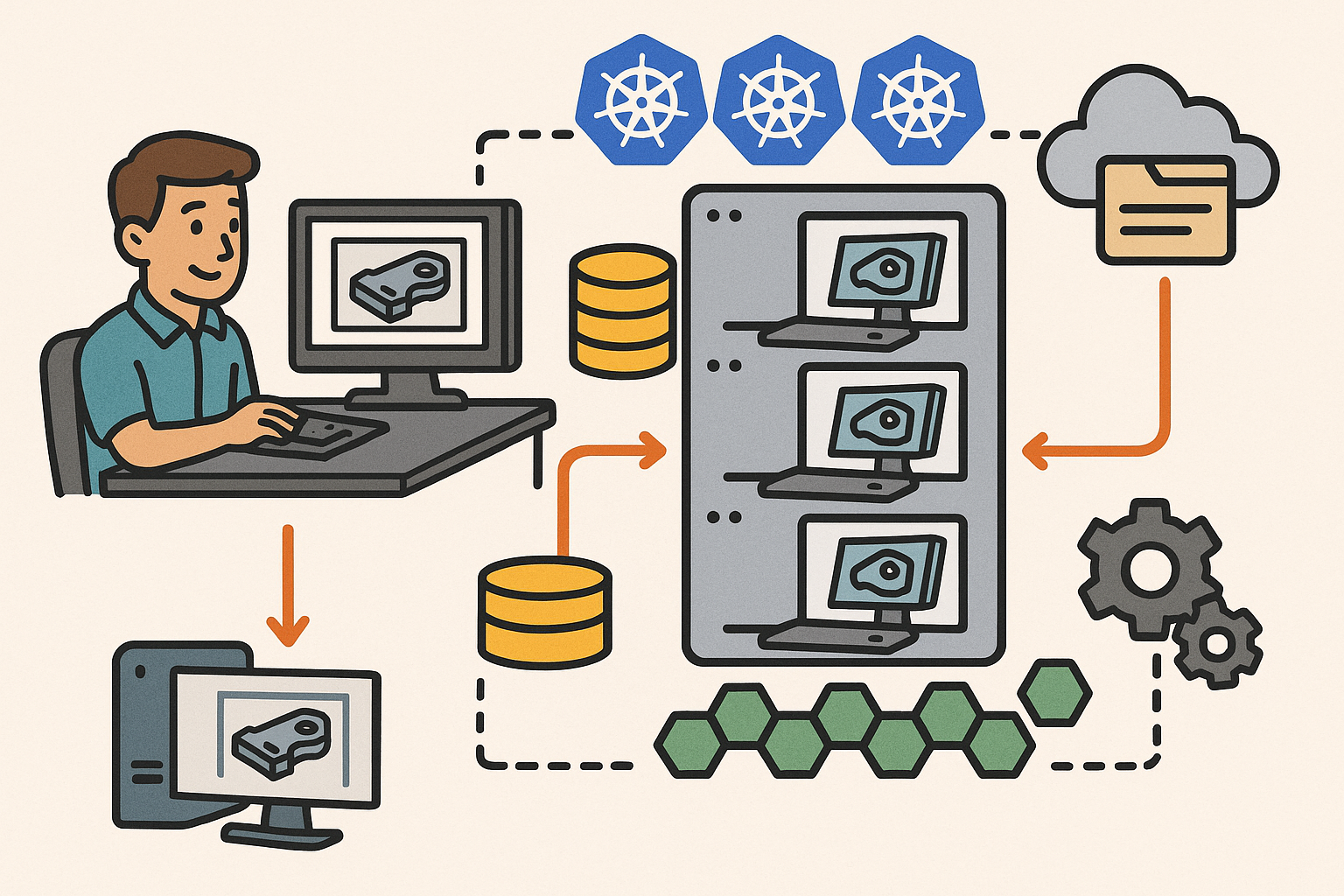Your Cart is Empty
Customer Testimonials
-
"Great customer service. The folks at Novedge were super helpful in navigating a somewhat complicated order including software upgrades and serial numbers in various stages of inactivity. They were friendly and helpful throughout the process.."
Ruben Ruckmark
"Quick & very helpful. We have been using Novedge for years and are very happy with their quick service when we need to make a purchase and excellent support resolving any issues."
Will Woodson
"Scott is the best. He reminds me about subscriptions dates, guides me in the correct direction for updates. He always responds promptly to me. He is literally the reason I continue to work with Novedge and will do so in the future."
Edward Mchugh
"Calvin Lok is “the man”. After my purchase of Sketchup 2021, he called me and provided step-by-step instructions to ease me through difficulties I was having with the setup of my new software."
Mike Borzage
Design Software History: The Evolution of Real-Time Rendering in CAD Software: From Sketchpad to GPU Innovations and Beyond
June 08, 2024 6 min read


The world of design software has undergone significant transformations since its inception. This blog delves into the rich history of design software, focusing on the evolution of real-time rendering in CAD (Computer-Aided Design) software. The journey spans from the early beginnings of computer graphics to the latest advancements that are shaping the future of design visualization.
The Genesis of Real-Time Rendering in CAD Software
Early Beginnings in Computer Graphics
The history of computer graphics is marked by several pioneering technologies that laid the foundation for modern design software. One of the most significant milestones was the development of Ivan Sutherland's Sketchpad in the 1960s. Sketchpad introduced a revolutionary way of interacting with computers through graphical interfaces, allowing users to create and manipulate images directly on a screen. This innovation not only marked the birth of interactive computer graphics but also set the stage for future advancements in CAD software.
Initial attempts at real-time rendering in the early days of computer graphics faced numerous limitations. Early computer systems lacked the processing power and memory capacity needed to render complex images in real-time. As a result, early real-time rendering techniques were rudimentary and could only handle simple geometric shapes and basic shading.
Development of Foundational Algorithms
The advancement of real-time rendering in CAD software was heavily reliant on the development of foundational algorithms and mathematical models. One of the key breakthroughs was the creation of the Z-buffer algorithm, which allowed for efficient depth sorting of pixels to determine visibility in a 3D scene. This algorithm, developed by Wolfgang Straßer, became a cornerstone of real-time rendering techniques.
Another notable figure in the development of real-time rendering algorithms is Ed Catmull. Catmull's work on texture mapping and shading techniques significantly contributed to the realism of computer-generated images. His contributions laid the groundwork for future advancements in rendering technology.
Early hardware requirements and constraints also played a crucial role in shaping the development of real-time rendering techniques. The limited processing power and memory of early computer systems necessitated the creation of efficient algorithms that could maximize the capabilities of the available hardware. This period saw the birth of many foundational techniques that continue to influence modern rendering methods.
The Advent and Influence of Graphics Processing Units (GPUs)
Introduction of GPUs and Their Impact
The introduction of Graphics Processing Units (GPUs) marked a significant turning point in the history of real-time rendering. Prior to the advent of GPUs, rendering tasks were primarily handled by Central Processing Units (CPUs), which were not optimized for the parallel processing required for efficient rendering. The shift from CPU to GPU processing allowed for substantial improvements in rendering speed and complexity.
Companies like NVIDIA and ATI (now AMD) played pivotal roles in the development and commercialization of GPUs. NVIDIA's release of the GeForce 256 in 1999 is widely regarded as the first GPU, and it heralded a new era of graphics performance. This milestone enabled more complex and realistic rendering in real-time applications, including CAD software.
The impact of GPUs on real-time rendering cannot be overstated. By offloading rendering tasks to specialized hardware, GPUs allowed for the creation of more detailed and visually stunning models. This advancement significantly enhanced the capabilities of CAD software, enabling designers and engineers to visualize their creations with unprecedented realism.
Software Adaptations and Innovations
The rise of GPUs also necessitated adaptations and innovations in software to fully leverage the new hardware capabilities. Early software that harnessed GPU power included graphics APIs like OpenGL and DirectX. These APIs provided a framework for developers to create applications that could efficiently utilize GPU resources for rendering tasks.
Industry leaders like John Carmack, co-founder of id Software, were instrumental in pushing the boundaries of GPU capabilities. Carmack's work on graphics engines for video games demonstrated the potential of GPUs for real-time rendering and inspired similar advancements in CAD software.
The integration of real-time rendering into CAD software was a gradual process, with early adopters setting the stage for widespread adoption. By leveraging the power of GPUs, CAD software developers were able to create tools that offered real-time visualization of complex models, greatly enhancing the design and engineering processes.
Evolution through the 2000s and Key Technological Advances
Refinement of Rendering Techniques
The 2000s saw significant refinements in rendering techniques, driven by advancements in both hardware and software. One of the most impactful developments during this period was the creation of advanced shaders. Shaders are small programs that run on the GPU and control the rendering of individual pixels, allowing for more sophisticated visual effects and greater control over the rendering process.
The introduction and adoption of ray tracing for real-time use marked another significant milestone. Ray tracing is a rendering technique that simulates the way light interacts with objects to create highly realistic images. Although traditionally used for offline rendering due to its computational complexity, advances in GPU technology enabled real-time ray tracing, greatly enhancing the visual quality of CAD models.
Companies like Autodesk and Dassault Systèmes played crucial roles in integrating these advanced rendering techniques into their CAD tools. By incorporating real-time ray tracing and advanced shaders, these companies provided designers and engineers with powerful tools for creating highly realistic models and visualizations.
Rise of Real-Time Rendering Engines
The impact of gaming engines like Unreal Engine and Unity on CAD and design cannot be overstated. Initially developed for creating video games, these engines offered powerful real-time rendering capabilities that were soon recognized for their potential in other fields, including CAD.
Examples of CAD software incorporating real-time rendering engines include tools that use Unreal Engine for enhanced visualization. By leveraging the capabilities of gaming engines, CAD software developers were able to provide users with interactive and immersive design experiences, greatly enhancing the visualization and presentation of their projects.
The collaboration between the gaming and CAD industries has been mutually beneficial, driving technological advancements that have pushed the boundaries of real-time rendering. This synergy has led to the development of new techniques and tools that continue to shape the future of design software.
The Future of Real-Time Rendering in CAD
Current Trends and Innovations
The current landscape of real-time rendering in CAD is marked by several exciting trends and innovations. One of the most promising developments is the role of artificial intelligence (AI) and machine learning in optimizing rendering processes. AI algorithms can analyze rendering workloads and automatically adjust settings to balance performance and visual quality, leading to more efficient and realistic renderings.
The impact of cloud computing and remote rendering services is another significant trend. By leveraging the vast computational resources of cloud servers, designers and engineers can perform real-time rendering tasks that would be impossible on local hardware. This approach also enables collaborative design workflows, with team members able to access and visualize models from anywhere in the world.
Emerging technologies like virtual reality (VR) and augmented reality (AR) are also making their mark on the CAD industry. VR and AR provide immersive visualization experiences that allow users to interact with their designs in new and intuitive ways. These technologies are particularly valuable for design review and presentation, enabling stakeholders to experience models as if they were physically present.
Future Prospects and Challenges
Looking ahead, several anticipated technological breakthroughs have the potential to further revolutionize real-time rendering in CAD. Improvements in GPU technology, AI algorithms, and cloud computing will continue to enhance rendering performance and quality. Additionally, the integration of VR and AR into everyday design workflows is expected to become more seamless and widespread.
However, several challenges remain on the horizon. Hardware requirements for high-quality real-time rendering can be prohibitively expensive, limiting accessibility for smaller firms and individual designers. Software integration is another challenge, as ensuring compatibility between different tools and platforms can be complex and time-consuming.
Visionaries and companies leading the next wave of innovation in real-time rendering for CAD include industry giants like NVIDIA, Autodesk, and emerging startups specializing in AI-driven rendering solutions. These leaders are continually exploring new ways to push the boundaries of what's possible, driving the field forward with each new advancement.
In conclusion, the history of design software is a story of continuous innovation and collaboration. From the early days of computer graphics to the latest advancements in real-time rendering, the journey has been marked by significant milestones and breakthroughs. As we look to the future, the ongoing evolution of rendering technologies promises to bring even more exciting possibilities for designers and engineers around the world.
Also in Design News

Rhino 3D Tip: True Intersections for Accurate, Repeatable Trim Curves
December 17, 2025 2 min read
Read More
Design Software History: Traceability as a Product Requirement: How Compliance Remade CAD, PDM, and PLM
December 17, 2025 10 min read
Read MoreSubscribe
Sign up to get the latest on sales, new releases and more …



